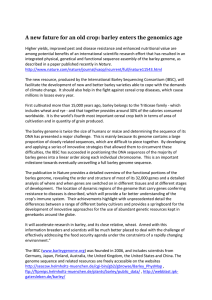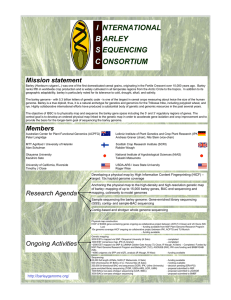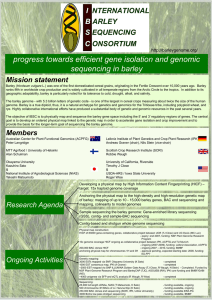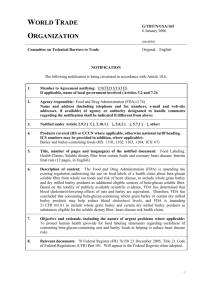The International Barley Genome Sequencing Consortium (IBSC) M
advertisement
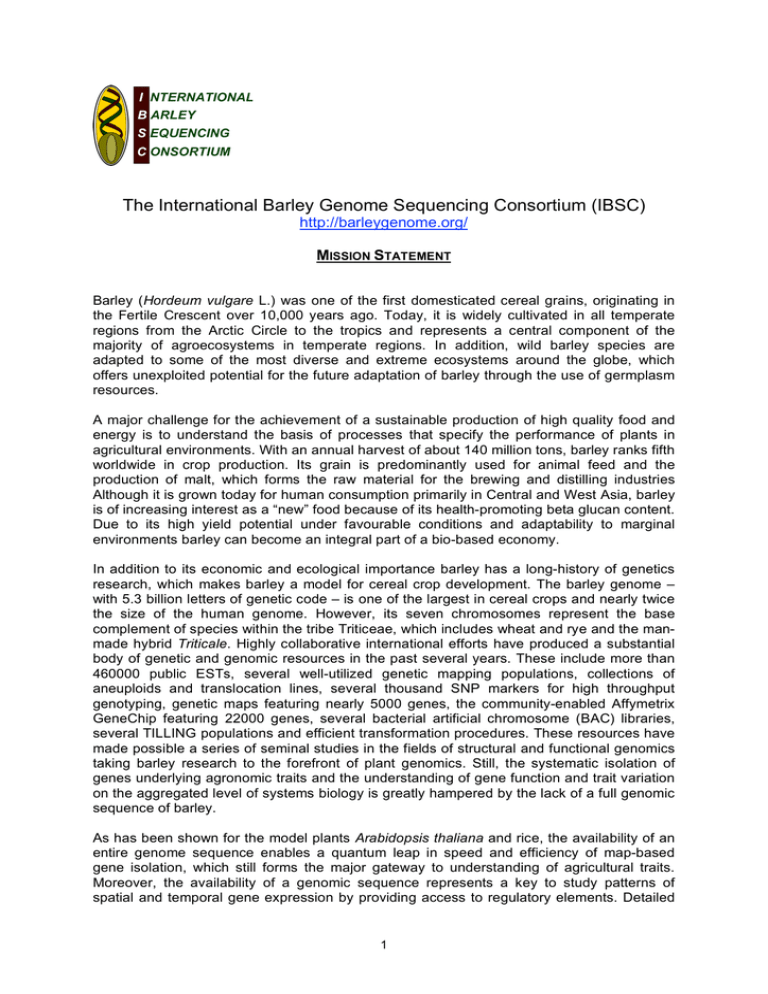
The International Barley Genome Sequencing Consortium (IBSC) http://barleygenome.org/ MISSION STATEMENT Barley (Hordeum vulgare L.) was one of the first domesticated cereal grains, originating in the Fertile Crescent over 10,000 years ago. Today, it is widely cultivated in all temperate regions from the Arctic Circle to the tropics and represents a central component of the majority of agroecosystems in temperate regions. In addition, wild barley species are adapted to some of the most diverse and extreme ecosystems around the globe, which offers unexploited potential for the future adaptation of barley through the use of germplasm resources. A major challenge for the achievement of a sustainable production of high quality food and energy is to understand the basis of processes that specify the performance of plants in agricultural environments. With an annual harvest of about 140 million tons, barley ranks fifth worldwide in crop production. Its grain is predominantly used for animal feed and the production of malt, which forms the raw material for the brewing and distilling industries Although it is grown today for human consumption primarily in Central and West Asia, barley is of increasing interest as a “new” food because of its health-promoting beta glucan content. Due to its high yield potential under favourable conditions and adaptability to marginal environments barley can become an integral part of a bio-based economy. In addition to its economic and ecological importance barley has a long-history of genetics research, which makes barley a model for cereal crop development. The barley genome – with 5.3 billion letters of genetic code – is one of the largest in cereal crops and nearly twice the size of the human genome. However, its seven chromosomes represent the base complement of species within the tribe Triticeae, which includes wheat and rye and the manmade hybrid Triticale. Highly collaborative international efforts have produced a substantial body of genetic and genomic resources in the past several years. These include more than 460000 public ESTs, several well-utilized genetic mapping populations, collections of aneuploids and translocation lines, several thousand SNP markers for high throughput genotyping, genetic maps featuring nearly 5000 genes, the community-enabled Affymetrix GeneChip featuring 22000 genes, several bacterial artificial chromosome (BAC) libraries, several TILLING populations and efficient transformation procedures. These resources have made possible a series of seminal studies in the fields of structural and functional genomics taking barley research to the forefront of plant genomics. Still, the systematic isolation of genes underlying agronomic traits and the understanding of gene function and trait variation on the aggregated level of systems biology is greatly hampered by the lack of a full genomic sequence of barley. As has been shown for the model plants Arabidopsis thaliana and rice, the availability of an entire genome sequence enables a quantum leap in speed and efficiency of map-based gene isolation, which still forms the major gateway to understanding of agricultural traits. Moreover, the availability of a genomic sequence represents a key to study patterns of spatial and temporal gene expression by providing access to regulatory elements. Detailed 1 knowledge of structural and regulatory components of the barley gene repertoire will facilitate the rational and systematic utilization of genetic diversity present in more than 450000 barley accessions stored in ex situ gene banks. The central position of barley within the Poaceae family will facilitate comparative studies on interspecific genome evolution. In particular, detailed comparison to the wheat genome will be crucial to reveal the effects of polyploidy and differential selection. Comparison to more distant lineages will help to reveal the presence of both ancient and recent segmental duplications and to understand the biological effects imparted by them. These types of studies will be important in understanding genome dynamics and the relationship between genome size and behaviour. Due to its salient agricultural importance, abundant genetic variation and multiple uses in the food and feed industry, barley has attracted the attention of many geneticists throughout the world. International networks have been established including the U.S. Barley Genome Mapping Program and the European Barley Genome Net (http://www.barleynet.org). The Barley Research Community is a major stakeholder in the International Triticeae Mapping Initiative (ITMI, http://wheat.pw.usda.gov/ITMI/) and in the European Triticeae Genomics Initiative (ETGI, http://www.etgi.org). These networks offer platforms to coordinate research efforts for barley, wheat and rye. During the recent ITMI meeting held from 27- 31 August 2006 in Adelaide representatives of the leading barley research groups in Australia, Europe, Japan and USA thoroughly reviewed and assessed the status of barley genomics. They reached the conclusion that it is now appropriate and entirely feasible to undertake a major, worldwide initiative to sequence the barley genome using state of the art sequencing technologies. It was agreed that this initiative should be characterized by: (i) shared use of existing resources, (ii) the continued coordination of ongoing research activities and (iii) a coordinated strategy to raise funding on the national and international level. The participants agreed on a common strategy, which will be outlined in a strategic research agenda shortly. To reach the goal of a genomic sequence of barley it was decided to form the International Barley Genome Sequencing Consortium (IBSC) (http://barleygenome.org/). The consortium will be charged to: - summarize the present status of research and resources development - prepare a strategic research agenda (white paper) - outline an agreed-upon sequencing strategy - further enhance the existing research network - coordinate activities to bundle projects into a generally agreed research program - provide an interface for the interaction with other sequencing consortia - garner political support - facilitate funding on the national and international level IBSC is formed by the following founding members representing leading research groups from the following institutions (in alphabetical order): Australian Centre for Plant Functional Genomics (ACPFG), AUS USDA-Agricultural Research Service (USDA-ARS) at Iowa State University (ISU), USA Leibniz Institute of Plant Genetics and Crop Plant Research (IPK), DEU National Institute of Agrobiological Sciences (NIAS), JPN Okayama University (OU), JPN Scottish Crop Research Institute (SCRI), GBR University of California Riverside (UCR), USA MTT Agrifood Research (MTT) & University of Helsinki (UH), FIN 2 Membership in the consortium will be open to any institution from the pubic and the private sector willing to provide an active, specific contribution. To implement the program of the consortium, a steering committee was nominated consisting of eight internationally renowned scientists: Timothy Close, Professor of Genetics, UCR, USA Andreas Graner, Head of Department, IPK, DEU Peter Langridge, Director, ACPFG, AUS Takashi Matsumoto, Head of plant genome research lab, RGP-NIAS, JPN Kazuhiro Sato, Associate Professor, OU, JPN Alan Schulman, Research Head, Genomics, MTT and Group Leader & Docent, UH, FIN Robbie Waugh, Program Leader Genetics, SCRI, Scotland, GBR Roger Wise, Research Geneticist, USDA-ARS and Professor, ISU, USA The participating institutions hereby confirm that they will actively collaborate towards whole genome sequence analysis of the barley genome. Several will contribute to support the effort by providing funding from their respective core budgets. All will support the efforts of IBSC members to acquire additional funding on the national and the international level. 3
